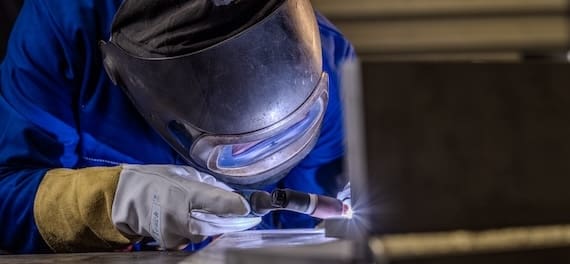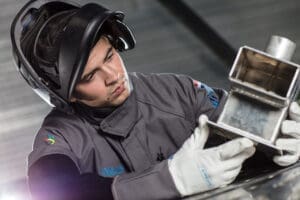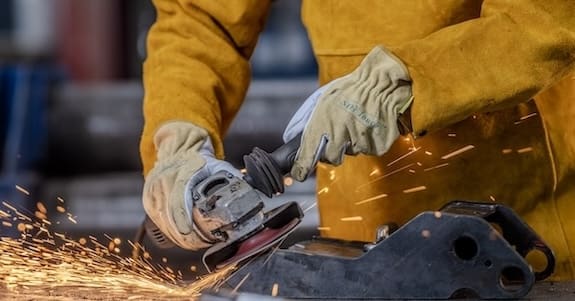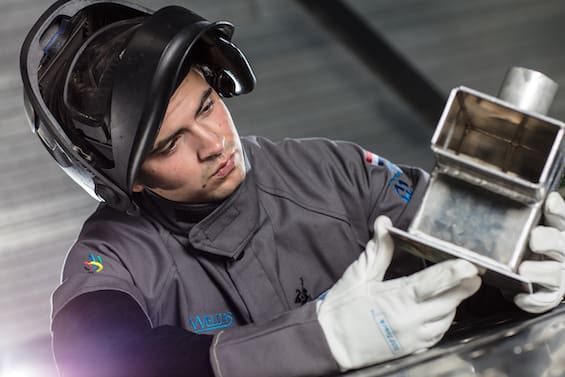
Vergleich der Schweißverfahren: TIG- und MIG-Schweißen
Das Schweißen ist eine wesentliche Technik, die in der Metallbearbeitung und im Bauwesen eingesetzt wird. Zwei häufig verwendete Schweißtechniken sind das MIG- und WIG-Schweißen. Es bestehen aber wesentliche Unterschiede zwischen MIG- und WIG-Schweißen, die ihre Anwendungen und Ergebnisse beeinflussen. Während wir im Vorfeld über den Unterschied zwischen MIG- und MAG-Schweißen geschrieben haben, beschreiben wir in diesem Blog im Detail den Unterschied zwischen MIG- und WIG-Schweißen und der dazugehörigen Bekleidung für die Schweißer.
Was ist das WIG-Schweißen?
Die Abkürzung TIG steht für Tungsten Inert Gas (Wolfram-Inertgas). Als Elektrode wird bei dieser Schweißtechnik Wolfram eingesetzt. Und genau wie beim MIG-Schweißen wird inertes Schutzgas verwendet. Das WIG-Schweißen gehört zur Kategorie des sogenannten „Lichtbogenschweißens“. Eine nicht schmelzende Wolframelektrode erzeugt den Schweißlichtbogen, während ein inertes Gas eingesetzt wird, um den Schweißbereich vor Verunreinigungen zu schützen.
WIG-Schweißen für hohe Genauigkeit
Das WIG-Schweißen gilt als eine der schwierigsten Schweißtechniken, die aber auch für seine Genauigkeit und Vielseitigkeit bekannt ist. Da der Wärmeeintrag sehr gut kontrolliert wird, können Schweißer sehr präzise und gut bearbeitete Schweißnähte herstellen. Aus diesem Grund wird das WIG-Schweißen häufig in Situationen gewählt, in denen Präzision von großer Bedeutung ist, wie dies beispielsweise beim Schweißen von dünnen Materialien, Edelstahl und Aluminium der Fall ist. Ein Vorteil des WIG-Schweißens besteht darin, dass während des Schweißverfahrens kaum Schweißspritzer oder Funken austreten. Die Fähigkeit, verschiedene Metalle mit minimalem Verzug und Spritzen zu schweißen, macht aus dem WIG-Schweißen eine hervorragende Technik für hochwertige Schweißprojekte, im Rahmen derer Ästhetik und Qualität von entscheidender Bedeutung sind.
Unterschied zwischen dem MIG- und WIG-Schweißen
Der auffälligste Unterschied zwischen dem MIG- und WIG-Schweißen besteht in der Art und Weise, auf die der Schweißdraht hinzugefügt wird. Beim MIG-Schweißen erfolgt diese Hinzufügung automatisch aus dem Schweißbrenner, während beim WIG-Schweißen der Zusatzdraht manuell in das Schweißbad geführt werden muss. Das WIG-Schweißen erfordert daher kontinuierlich den Einsatz von zwei Händen. Ein weiterer Unterschied besteht in der Verwendung einer konstanten Stromstärke während des WIG-Schweißverfahrens im Gegensatz zur konstanten Spannung beim MIG/MAG-Schweißen.
Darüber hinaus unterscheiden sich die Schweißtechniken auch in der Schweißgeschwindigkeit und -qualität. Der Hauptvorteil des MIG-Schweißens ist die hohe Schweißgeschwindigkeit, die das Verfahren erheblich beschleunigt. Auf der anderen Seite führt das WIG-Schweißen zu einer höheren Schweißnahtqualität.
Welches Gas muss für das WIG-Schweißen verwendet werden?
Beim WIG-Schweißen wird typischerweise 100 % Argon als inertes Schutzgas verwendet. Dasselbe ist beim MIG-Schweißen von Aluminium der Fall. Diese Art von Schutzgas erzeugt einen stabilen Lichtbogen und schützt auf diese Weise die Schweißnaht effektiv vor Oxidation. Argon besitzt die Eigenschaft, während des Schweißverfahrens eine saubere Umgebung zu erhalten, wodurch es besonders zum Schweißen von Nichteisenmetallen wie beispielsweise Aluminium und Edelstahl geeignet ist. Argon wird auch manchmal mit Wasserstoff gemischt. Dies erfolgt beispielsweise für das WIG-Schweißen von korrosionsbeständigem Stahl.

Persönliche Schutzausrüstung für das WIG-Schweißen
Die persönliche Schutzausrüstung (PSA) spielt beim Schweißen eine wesentliche Rolle. Obwohl das WIG-Schweißen mit minimalen Funken und glühenden Schweißspritzern verbunden ist, ist dennoch ein ausreichender Schutz erforderlich. Mit Hilfe der WIG-Schweißhandschuhen schützen Sie Ihre Hände und Arme vor der Hitze und Strahlung, die beim Schweißen erzeugt wird. Als Spezialist für den Schweißschutz bietet das Unternehmen Weldas verschiedene Lösungen für den WIG-Schweißer an, darunter hochwertige Lederschweißhandschuhe und Schweißbekleidung.
Die Eigenschaften der WIG-Schweißhandschuhe
Ein hochwertiger Schweißhandschuh für das WIG-Schweißen erfüllt mehrere Haupteigenschaften, darunter Sicherheit, Komfort, Benutzerfreundlichkeit und Gesundheit. Während die MIG-Schweißhandschuhe gefüttert sind, ist dies bei den SOFTouch™-Schweiß-WIG-Handschuhen nicht der Fall.Dennoch halten sie dank der Verwendung verschiedener Ledersorten viel Hitze stand. Beim WIG-Schweißen ist die Fingerempfindlichkeit entscheidend, da der WIG-Schweißer den Schweißdraht manuell zuführen muss. Daher ist es wichtig, dass die WIG-Schweißhandschuhe einen hervorragenden Halt bieten, damit der Schweißer den Schweißdraht und andere kleine Schweißteile sicher halten kann.
Darüber hinaus ist die Genauigkeit beim WIG-Schweißen von wesentlicher Bedeutung. Um eine gute Stabilität zu schaffen, lehnt sich der Schweißer oft an das zu bearbeitende Werkstück an. Die längere Manschette der Handschuhe für das WIG-Schweißen ermöglicht es dem Schweißer, seinen Unterarm auf dem Werkstück abzustützen. Ein weiteres nützliches Werkzeug ist der WIG-Finger-Hitzeschild. Dieser WIG-Finger bietet etwas zusätzliches Material für die Unterstützung auf heißen Oberflächen, so dass der Schweißer eine stabile Haltung seiner Hand beibehalten kann. Der WIG-Finger wird manchmal auch als Stütze für die Schmelzelektrode beim Elektrodenschweißen eingesetzt.
TIG-Schweißbekleidung
Neben den TIG-Schweißhandschuhen ist das Unternehmen Weldas auch die ideale Adresse für Schweißschutzkleidung, von Schweißjacken bis Schürzen, von Latzhosen bis Fußschutz. Unser umfangreiches Sortiment umfasst sowohl hochwertige Lederschweißbekleidung als auch bequeme und schwer entflammbare Baumwolle. Sehen Sie sich unser gesamtes Sortiment an oder kontaktieren Sie uns für eine Beratung.


